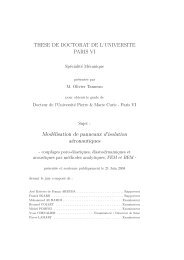THESE DE DOCTORAT DE L'UNIVERSITE PARIS VI - LISMMA
THESE DE DOCTORAT DE L'UNIVERSITE PARIS VI - LISMMA
THESE DE DOCTORAT DE L'UNIVERSITE PARIS VI - LISMMA
You also want an ePaper? Increase the reach of your titles
YUMPU automatically turns print PDFs into web optimized ePapers that Google loves.
MO<strong>DE</strong>LE GENERAL ET PRE<strong>VI</strong>SION A LONGUE DUREEPosons E ′ (t) = E(t − t 0 ), la contrainte est donc la suivante :S ′ (t) = Φ[E ′ (t), 0 + ]E ′ (t) −∫ t0∂Φ[E ′ (τ), ψ ′ (t) − ψ ′ (τ)]dτ: E ′ (τ)dτ (2.7)ψ ′ (t) =∫ t0dsα S [S ′ (s),t−s]avec S ′ (s) = S(s − t 0 )Par changement de variable : s − t 0 = θ, on aψ ′ (t) =t−t ∫ 0−t 0t−tdθ= ∫ 0α S [S(θ),t−t 0 −θ]0dθ+ ∫0α S [S(θ),t−t 0 −θ]−t 0= α S0 = Cons tan tela contrainte étant causale S(θ) = 0, pour θ < 0dθα S [0,t−t 0 −θ]α s [0, t − t 0 − θ] = α 0 est constant dans la deuxième intégrale.Finalement, on a :ψ ′ (t) = ψ(t − t 0 ) + t 0α S0(2.8)En prenant en compte la causalité de la fonction de relaxation Φ, il vientdonc d’après les deux relations 2.7 et 2.8 :∫S ′ (t) = Φ[E(t−t 0 ), 0 + t] : E(t−t 0 )−Posons s = τ − t 0⇒∫ t0t−t ∫ 0• dτ = • ds =−t 00∂Φ[E(t−t 0 ),ψ(t−t 0 )−ψ(τ−t 0 )]dτt−t ∫ 0Les fonctions étant causales, il vient finalement :0• ds: E(τ −t 0 )dτS ′ (t)= Φ[E(t − t 0 ), 0 + ] : E(t − t 0 ) −= S(t − t 0 )t−t ∫ 00∂Φ[E(t−t 0 ),ψ(t−t 0 )−ψ(s)]∂sCe qui établit l’invariance du modèle dans le temps.: E(s)ds(2.9)72








